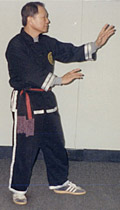Meditation
Though the T'ai Chi Solo form is also about meditation and relaxation, we wanted to touch upon some of the other practices: mainly Taoist Standing Meditation and C'hi Kung (literally "Vital Energy Work"). The standing meditation is common in Taoist society and represents the connection of the 3 treasures. The Human stands with feet connected to the Earth and crown of the head (Pai Hui) connected to Heaven. Ch'i Kung has origins in medical, Taoist scholar, and even religious practices such as the ones used in the Shaolin Temple. There are literally hundreds of Ch'i Kungs out there. Grandmaster Choi Wai Lun has a book with around 500 Ch'i Kung sets in it.
Standing Meditation
I Ch'uan
The Yi Ch'uan is a martial art in it's own right, but it is often practiced as a standing meditation that builds abundant Ch'i. The feet are about shoulder width apart with the toes pointing out about an inch. This stance offers the practitioner the ability to stand for much longer periods of time than the Wu Chi stance with the feet parallel. There are 6 arm positions that are held for as long as you are able to remain relaxed. The postures touch upon the 3 Tan T'iens: the Lower Tan T'ien ("Field of Cinnabar" or "Elixir Field") just below the navel, the Middle Tan T'ien at the Heart or Solar Plexus area, and the Upper Tan T'ien in the center of the forehead between the eyebrows. The 3 Tan T'ien areas are very common to most Taoist standing meditation. And their name is a technical term used in spiritual Alchemy. Cinnabar means the Alchemical metal "Mercury".

Hsing I Ch'uan - San Ti
The art of Hsing Yi Ch'uan has a standing practice called San Ti. There are 3 ways to practice: High (knees just barely bent), Medium (Knees visibly bent), and Low (knees very bent). The posture looks like P'i Ch'uan the "Splitting Fist" which is also attributed to the element Metal. The idea is to have the body as relaxed as possible while holding the posture. This posture builds Ch'i quickly and stores it in the Lower Tan T'ien which is known as the "Residence of the Ch'i".
Pa Kua Chang - Serving Tea
The art of Pa Kua Chang has a practice called "Serving Tea" which has the palms facing upward the whole time as if holding a teacup in each of them. Legend has it that Disciples would actually serve tea to their masters without spilling a drop. This practice stretches all the muscles and tendons in the shoulders while training the arms to move in coordination with each other.
Small Heavenly Circle or Microcosmic Orbit
The circle or "orbit", as it's sometimes called, refers to the path the Ch'i moves along inside the body. It travels along two of the major 8 accupuncture meridians moving down the front and up the back. The movement is directed by the mind intent. There's an often quoted phrase in Taoist meditation and internal martial art that says "where the mind goes the Ch'i folows". This practice could be done in a sitting position since the circle only goes down to the base of the spine before moving upward along the back. The heavenly circles, both small and large, are often added to the Ch'i Kung exercises as an advanced practice.
Large Heavenly Circle or Macrocosmic Orbit
What makes this the "large" circle is that the path goes from the forehead down to the base of the spine, then down the legs to the bottoms of the feet, then returns up the legs and up the back. The arms are included and "fill up" in time with the legs. This circle is especially good for standing meditaion as it really gives the sense of connection with the earth. So here we have the Ch'i moving throughout the entire body nourishing the body and circulating the blood to the extremities.
Ch'i Kung
T'ai Chi Ch'i Kung
Originally a practice from created in Shanghai, the Yang family added it to their repetoir. Yang family T'ai Chi was still developing at this time and they would often incorporate other forms and practices into their system. This Ch'i Kung is done with the feet completely planted, but the rest of the body is worked and stretched. In the advanced stages of this practice, the Small Heavenly Circle meditation is added to further enhance it.
"Tree Kung"
A Ch'i Kung created by Master Ray Hayward, this Ch'i Kung emulates a tree opening upward to receive the sun's energy. This also stimulates the 3 Tan T'iens.
Meridian Stretches
Created by Masunaga Sensei in Japan, the Meridian stretches work the areas along the same accupunture meridians that the Taoists use for the Heavenly Circles which move down the front of the body and up the back. He wrote a book that is now out of print called Zen Imagery Exercises by Shizuto Masunaga. The book is hundreds of pages and is well worth having if you can find it.
Sipping Ch'i
Similar to the Small Heavely Circle, the Sipping Ch'i practice has the same path but focuses on each accupoint on the 2 meridians moving down the front and up the back (Jen Mo and Tu Mo). It's like a connect-the-dots drawing where each point that is concentrated on draws a line to it from the previous point. So, the orbit is visualized much slower than in the Small Heavenly Circle, but each area becomes stimulated and activated. This can also be done from a seated position.
Five Animal Frolics
Based on the movements of five animals (Crane, Bear, Deer, Monkey, and Tiger), this Ch'i Kung stretches the body while building internal energy.